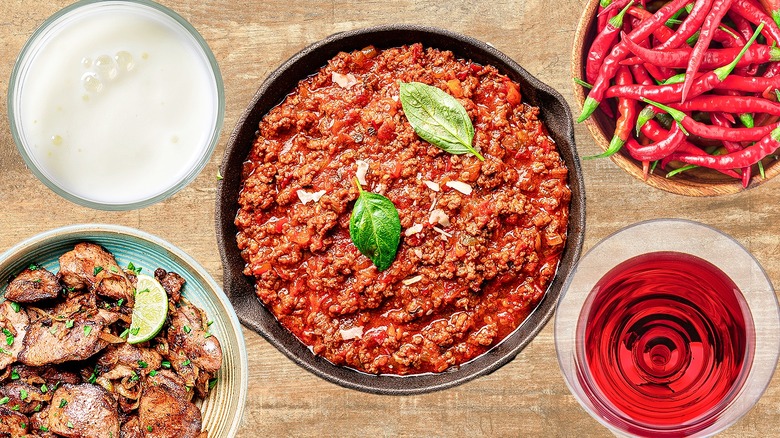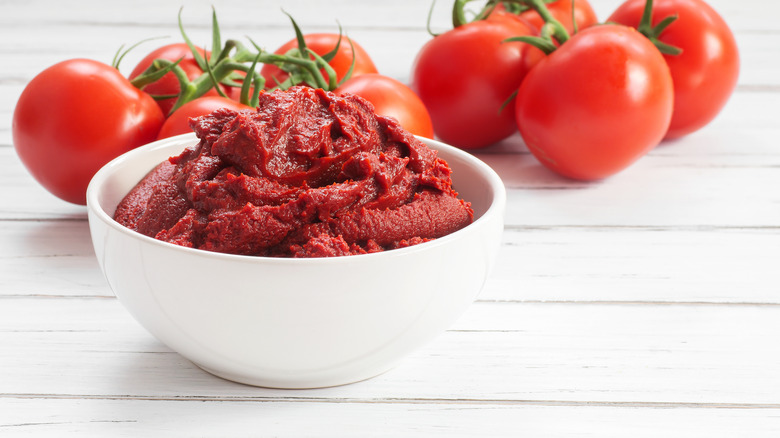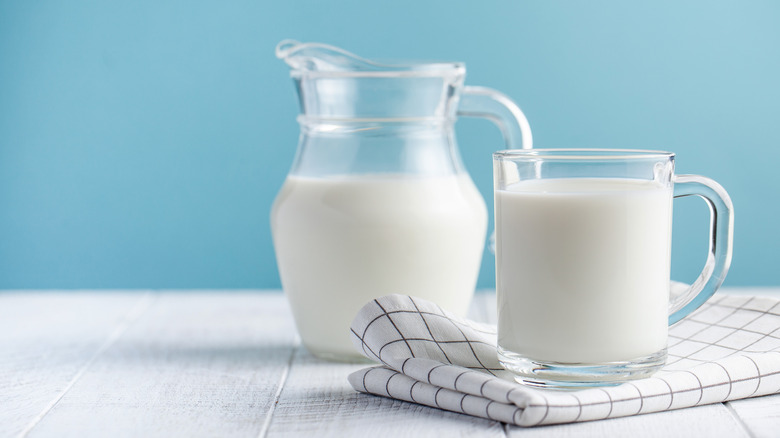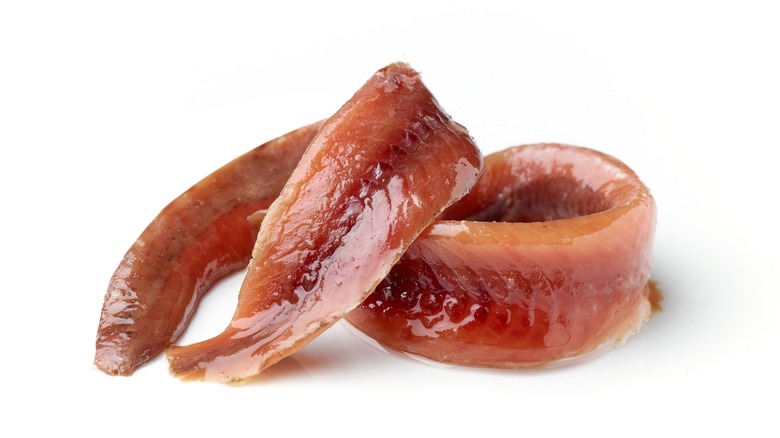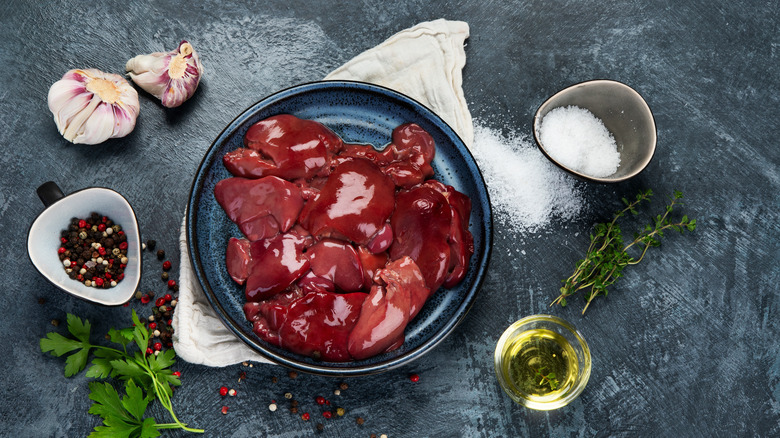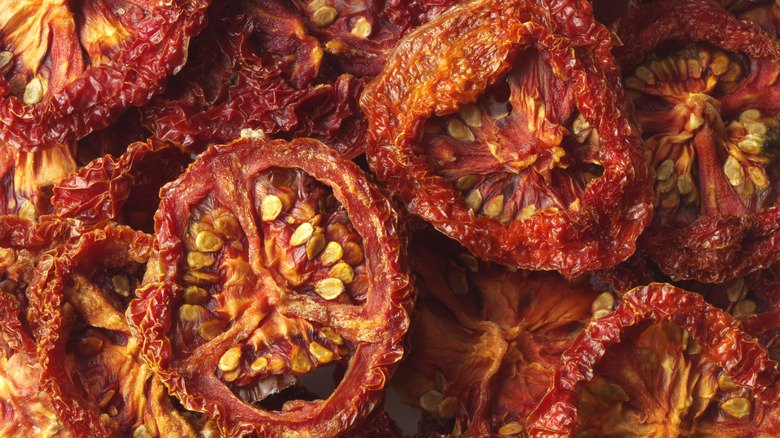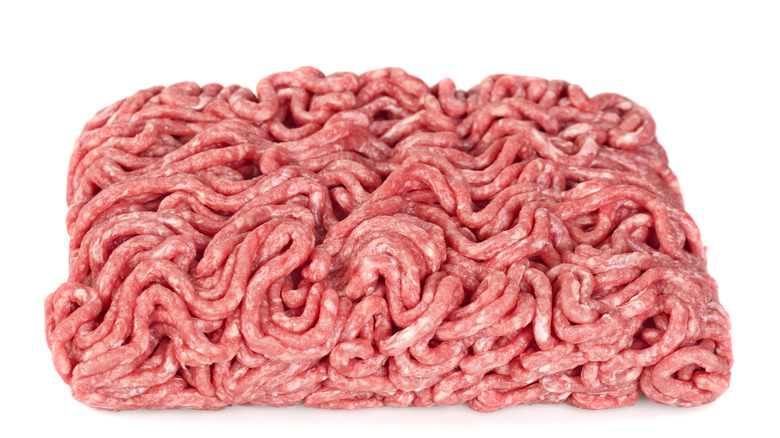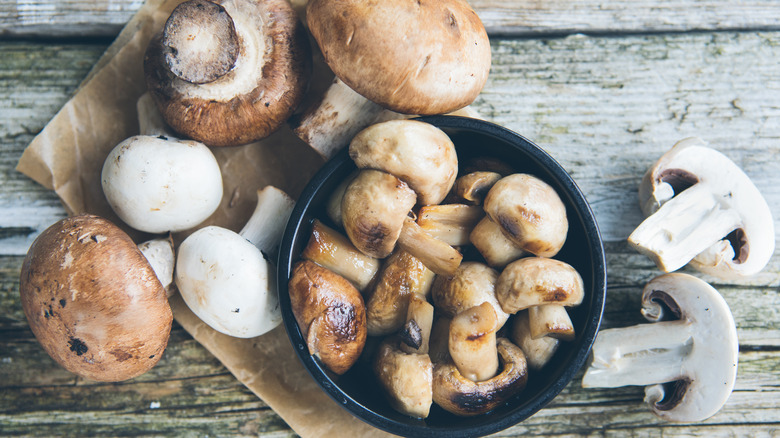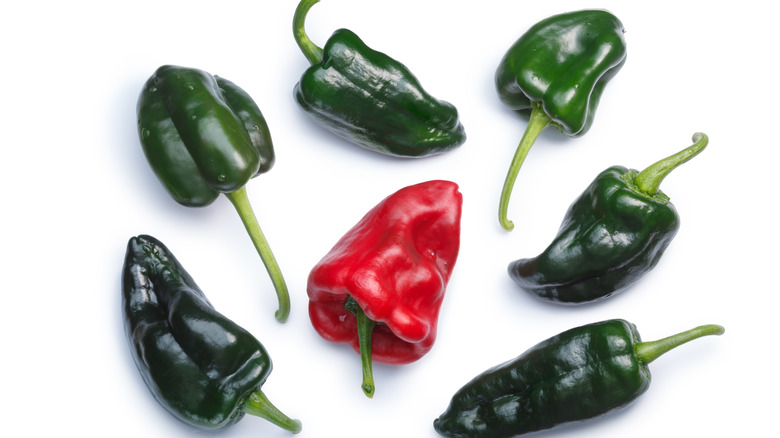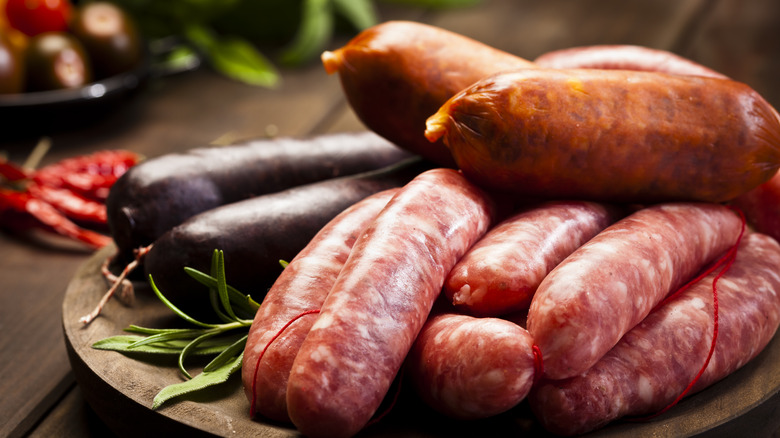11 Ingredient Additions For Better Bolognese Sauce
Bolognese sauce, from the city of the same name in the northern region of Emilia Romagna, might be one of Italy's most iconic dishes. Although this simple ragu is just a combination of tomato sauce and ground meat with a few choice herbs and vegetables, its influence and popularity cannot be overstated. Its robust flavor and wide reach also allow it to effortlessly take on variations of all kinds, incorporating new ingredients in each kitchen it graces — some of which are more appropriate than others.
First let's get the basics straight. You need to know the rules before you can break them, so start your quest for the perfect Bolognese by taking a look at our 14 tips for making Bolognese sauce. You will see just how important it is to take your time, select the right ingredients, and prepare them perfectly. You might also be surprised to find that, if you want your Bolognese to be as authentic as possible, you should avoid serving it with spaghetti — that is an American invention that somehow supplanted the traditional fresh tagliatelle, a much better choice for capturing the sauce.
Caramelized tomato paste
You may wonder what the point of a little tomato paste is when you're dealing with a sauce prepared with several cans of whole tomatoes. Isn't that just a drop in the red, tomatoey ocean? Far from it. This little fellow plays a big role in the thickening of the sauce. When cooked, it can also add depth of flavor to the sauce as its sugars are released into the mix.
It is especially true when the tomato paste is caramelized. This can be achieved by adding your tomato paste to the pan after the deglazing process. For an even stronger flavor, you can add it to your sauteed vegetables right before they're done cooking, then deglaze the pan after the caramelization is complete. If you want more control over the process, some Bolognese recipes recommend caramelizing the tomato paste on its own in a separate pan with some olive oil. The benefit of this method is that you can watch the color of the paste shift from bright red to the proper darker burgundy color it should be. Whichever method you choose, be sure to stir the paste frequently as it cooks, or it risks burning or sticking to the pan.
Milk
Although it may not look like it — or even taste like it — whole milk is a key ingredient in the OG Bolognese recipe. Without it, the sauce would still be pretty good. Indeed, there are plenty of recipes out there that don't call for it, including that of Italian food maven Giada De Laurentiis. In addition to the benefits of tradition and the idea of standing the test of time, the milk component adds a depth of taste and a flavor development. This just wouldn't take place without the addition of the dairy product, an ingredient that might just change your Bolognese sauce forever.
For maximum effect, many recipes call for the milk to be added to the browned meat along with the chicken stock after the pan has been deglazed. As per our classic ragu alla Bolognese recipe, you can even add nutmeg and Parmesan rind at this stage as well. Then, it's time to just sit back and wait for the sauce to cook and thicken, which usually takes about 45 minutes from this point. Don't worry about overcooking this baby: unless you cook it to the point of drying out, spending time on the stove on low heat is only going to allow the flavors to further mingle. In fact, you might just find that the dish is even tastier a day or two later after additional flavor blending has taken place.
Red wine
Although many recipes call for white wine, red wine can be just as enticing in Bolognese, at least according to Ina Garten, and she would know. In fact, she is so sure of this choice that she uses not one cup of red wine, but two. The first one comes where you might expect: after the meat has finished browning and it's time to deglaze the pan — but the second cup is when the real flavor kicks in. Although the first cup serves a very important purpose of adding depth of flavor, the wine will be largely cooked off by the time the dish is ready. The second cup, on the other hand, goes in near the end, so that the sauce will retain that extra kick of acidity — even as it's served at the table.
For this trick, Ina Garten recommends using a dry red wine. She goes for Chianti, but you can easily choose any of the myriad other options. If the prospect of selecting a red wine to cook with (and probably drink) daunts you, we have you covered there, too. There are many wine guides that you can turn to, but you can start by reviewing our list of every major type of red wine you need to know about.
Fish sauce
Fish is that sneaky ingredient many chefs slip into their sauces and serve to unsuspecting diners. Anchovies, for one, is used to flavor the classic puttanesca sauce. However, it's also used by the likes of Giada De Laurentiis, who recommends home cooks use this ingredient, and Bobby Flay, who puts them in almost everything. Whole anchovies aren't the only option here — any type of good quality fish sauce can elevate your Bolognese, or any other tomato-based sauce, just with a flick of the wrist as you pour a few drops into the pan.
Typically a little bit sweet, a little bit salty, and very much full of umami, this blend, such as colatura di alici, is made with fermented fish that has been pressed into a sauce. Because it's typically made with anchovies, expect a strong flavor. When adding it to your sauce, be sure to use a little at a time or you'll risk overwhelming the rest of the flavors. A little bit goes a long way toward giving your sauce an extra layer of taste.
Chicken liver
Liver doesn't have the best of reputation in American households. One of the reasons for this is its unique earthy flavor, which is definitely an acquired taste. Another is that historically, liver hasn't been given its due, meaning it often hasn't been cooked correctly. Many American households have tended to overcook it over the years, as The New York Times reported back in 1985 when it was still reasonably common.
Here we propose to remove the yuck factor of liver by providing instructions on how to cook it correctly. In particular, this ingredient can do a lot of good when included in your Bolognese sauce. When cooked this way, chicken liver can become creamy and even silky, giving your sauce a beautifully rich texture. The best way to do this is to saute the liver separately, caramelizing it before adding it to the rest of the sauce. When cooking it this way, it will disintegrate and blend in with the rest of the ingredients, adding flavor and texture without reminding you of those uncomfortable liver connotations.
Sun-dried tomatoes
Tomatoes are an undeniable ingredient in any Bolognese (unless you're making a white version, such as this turkey bolognese bianco, for example, but that's another story). Typically, those tomatoes come in canned form, but if you haven't considered swapping in or adding sun-dried tomatoes to your Bolognese, now is the time. Sun-dried tomatoes are jam-packed with flavor — they're essentially concentrated versions of a fresh or canned tomato — so they can add even more flavor to your Bolognese.
To incorporate them, follow this quick ragu alla Bolognese recipe and add them at the beginning with the onions and vegetables. This 30-minute recipe can be used because the sun-dried tomatoes also help shorten the cooking time of the sauce. It typically takes several hours in order to allow the flavors to thoroughly blend together. The sun-dried tomatoes add that much-needed complexity early on — just be sure to chop up those little fellows before tossing them in the pan. They usually come in large and flat discs and can be a bit of a mouthful when taken whole.
Well-marbled ground beef
Quality of ingredients is important when gathering items for any recipe. It's particularly important to pay special attention to the beef chuck when making Bolognese, since it plays such a prominent role in the recipe. Our suggestion is to look for well-marbled chuck. That marbling isn't just a pretty feature: the white strains indicate a good amount of fat, which should be evenly spread out. Fat, in turn, provides a richer flavor to the meat and anything that contains it, thereby giving the Bolognese sauce a rich texture and flavor.
To look for the perfect specimen, head to your butcher and specifically ask for beef chuck that has been made from the neck of the cow. This tends to have more marbling than the shoulder or ribs. Just remember that this cut can also be on the tough side, but that shouldn't be a problem — Bolognese requires long cooking times to ensure a good blend of flavors, and during that lengthy process, the chuck should have plenty of time to tenderize.
Mushrooms
Mushrooms are a great ingredient for adding protein and a whole bunch of other nutrients. In vegetarian dishes, they can make an ideal centerpiece for a vegetarian Bolognese, such as in Anne Burrell's recipe. However, they can also be enjoyed by meat-eaters, as they make an excellent addition to any classic, meat-filled Bolognese sauce. Indeed, the original recipe dating back to the 1800s named dried mushrooms as an optional addition to the sauce, suggesting it would thus be made "even better," according to the International Journal of Arts and Humanities.
To see if that's true, you can add mushrooms to your Bolognese, thereby adding texture and an extra layer of flavor to your sauce. The best way to do this is to swap out some of your beef for some mushrooms, effectively making it a half-and-half blend of beef and mushrooms. Then, finely chop your mushrooms or pulse them in a food processor. Add them to your pan after sauteing your vegetables, along with the meat. Deglaze everything together and proceed as you would with any other Bolognese recipe.
Chili peppers
One quick and easy upgrade for many recipes is to simply make them spicy. Bolognese sauce, with its reach and versatility, makes an excellent candidate for this doctoring technique. However, there are many ways to do it. There's nothing wrong with simply adding a few hot pepper flakes to your meat sauce at any point doing the cooking process (though early on is better, to ensure it mingles properly) or swapping in some spicy sausage for some of that beef chuck. That being said, we have a more specific and sophisticated suggestion.
Our poblano Bolognese pasta is an ideal way to add heat to your sauce, along with a new flavor element from the whole pepper. To make this, start by browning the ground beef chuck in a pan and separately sauteing finely chopped carrots, onions, and celery. Deglaze this pan with some dry white wine before adding the cooked beef along with canned whole tomatoes, bay leaves, nutmeg, and thyme sprigs. While this sauce is cooking and becoming much more than the sum of its parts, saute the garlic separatel, and add a finely chopped poblano pepper until blistered. Then, mix it in with the Bolognese sauce, along with heavy cream and some reserved cooking water from the prepared pasta.
Rosé
While some Bolognese recipes call for white wine and others accommodate red wine perfectly well, few have attempted the obvious compromise option: rosé. Lady Gaga, who has Italian roots and is apparently a very good cook, is one of these precious few. Indeed, her parents own and operate an Italian restaurant in New York called Joanne Trattoria, so it seems that cooking is in her blood.
To give Lady Gaga's Bolognese sauce a try, simply follow any weeknight pasta Bolognese recipe. When it's time to add the dry white wine, just swap in some good rosé. One reason why you don't often see this wine choice in recipes is because Bolognese requires a dry wine — the last thing you want to do is add too much sweetness to this hearty sauce — and many rosés can be a bit too sweet. Make sure that when you select your wine, you're going for a very dry version. Start by learning a bit about the different types of rosé that are out there, and you'll be well on your way.
Pork
One easy way to give an extra dimension of flavor to your meat sauce is to add a different type of ground meat to your regular beef chuck. Ground veal is a popular choice, but so is pork — its extra fat content can help support beef marbling in its quest to provide the dish with maximum flavor and thick texture. When it comes to pork, the real star of the show is pork sausage. Not only can this ingredient add flavor to your sauce, but it can also shorten the cooking time. This is because most sausage meat is already pre-seasoned and flavors are pre-mingled.
To put this tip into action, pull out some links of Italian sausage and remove the casings, which will leave you with the pure, naked meat mash. Then, simply brown it along with the beef chuck when your usual recipe calls for it. At this point, all you have to do is continue following your recipe as you normally would, minus all that cooking time.
